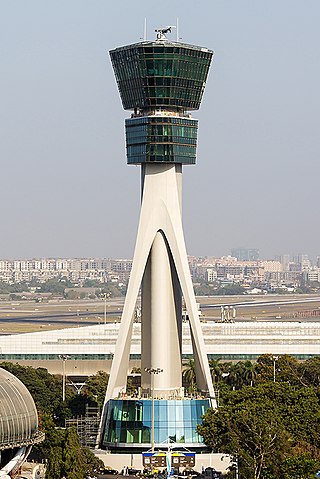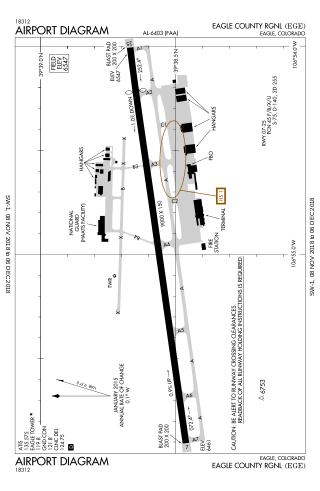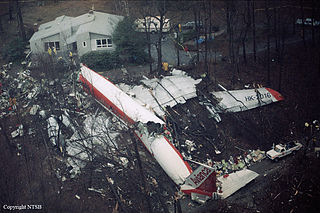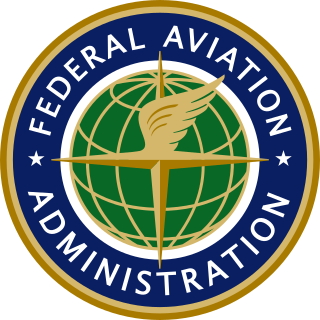
Los Angeles International Airport is the primary international airport serving Los Angeles and its surrounding metropolitan area, in the U.S. state of California. LAX is located in the Westchester neighborhood of the city of Los Angeles, 18 miles southwest of Downtown Los Angeles, with the commercial and residential areas of Westchester to the north, the city of El Segundo to the south, and the city of Inglewood to the east. LAX is the closest airport to the Westside and the South Bay.

Air traffic control (ATC) is a service provided by ground-based air traffic controllers (people) who direct aircraft on the ground and through a given section of controlled airspace, and can provide advisory services to aircraft in non-controlled airspace. The primary purpose of ATC worldwide is to prevent collisions, organise and expedite the flow of traffic in the air, and provide information and other support for pilots.

Air traffic control specialists, abbreviated ATCs, are personnel responsible for the safe, orderly, and expeditious flow of air traffic in the global air traffic control system. Usually stationed in air traffic control centers and control towers on the ground, they monitor the position, speed, and altitude of aircraft in their assigned airspace visually and by radar, and give directions to the pilots by radio. The position of air traffic controller is one that requires highly specialized knowledge, skills, and abilities. Controllers apply separation rules to keep aircraft at a safe distance from each other and within proper airspace in their area of responsibility and move all aircraft safely and efficiently through their assigned sector of airspace, as well as on the ground. Because controllers have an incredibly large responsibility while on duty and make countless real-time decisions on a daily basis, the ATC profession is consistently regarded around the world as one of the most mentally challenging careers, and can be notoriously stressful depending on many variables. Many controllers, however, cite high salaries, and a large, unique, and privileged degree of autonomy as major advantages of their jobs.

Eagle County Regional Airport is in Gypsum, Colorado, United States, 4 miles from Eagle and 37 miles from Vail. It covers 632 acres (256 ha) and has one runway. The History Channel rated Eagle County Regional Airport as #8 on its list of Most Extreme Airports in July 2010 due to the elevation, weather, approach through mountainous terrain and challenging departure procedures. In 2008–09 the airport completed a runway repaving and extension project, increasing the runway length to 9,000 feet.

Avianca Flight 052 was a regularly scheduled flight from Bogotá, Colombia, to New York City, United States, via Medellín, Colombia, that crashed on January 25, 1990, at 21:34 (UTC−05:00). The Boeing 707 flying this route ran out of fuel after a failed attempt to land at John F. Kennedy International Airport (JFK), causing the aircraft to crash onto a hillside in the small village of Cove Neck, New York, on the north shore of Long Island. Eight of the nine crew members and 65 of the 149 passengers on board were killed. The National Transportation Safety Board (NTSB) determined that the crash occurred due to the flight crew failing to properly declare a fuel emergency, failure to use an airline operational control dispatch system, inadequate traffic flow management by the Federal Aviation Administration (FAA), and the lack of standardized understandable terminology for pilots and controllers for minimum and emergency fuel states.

On the evening of February 1, 1991, USAir Flight 1493, a Boeing 737-300, collided with SkyWest Airlines Flight 5569, a Fairchild Swearingen Metroliner turboprop aircraft, upon landing at Los Angeles International Airport (LAX). As Flight 1493 was on final approach, the local controller was distracted, though air traffic was not heavy at LAX, by a series of abnormalities, including a misplaced flight progress strip and an aircraft that had inadvertently switched off the tower frequency. The SkyWest flight was told to taxi into takeoff position, while the USAir flight was landing on the same runway.

Pushing Tin is a 1999 American comedy-drama film directed by Mike Newell. It centers on Nick Falzone, a cocky air traffic controller who quarrels over proving "who's more of a man" with fellow employee Russell Bell. The film is loosely based on the real-world New York TRACON radar facility. The film was a box-office failure and received mixed reviews. The original music score was composed by Anne Dudley and Chris Seefried.

In air traffic control, an area control center (ACC), also known as a center or en-route center, is a facility responsible for controlling aircraft flying in the airspace of a given flight information region (FIR) at high altitudes between airport approaches and departures. In the US, such a center is referred to as an air route traffic control center (ARTCC).

TRACON is a series of game software programs that simulate an air traffic control environment on a personal computer. The games were originally sold by Texas-based Wesson International as an offshoot to their line of professional air traffic control simulation products. TRACON and RAPCON were released in 1989, and TRACON II was released in 1990. Wesson was merged into Adacel in 2001.

The New York Terminal Radar Approach Control (TRACON) is located in the East Garden City neighborhood of Uniondale, on Long Island, New York. New York TRACON, also known as N90, is a type of Federal Aviation Administration air traffic control facility known as a consolidated TRACON, meaning that a single location provides approach service for several large airports. It is headquartered at 1515 Stewart Avenue.
The Philadelphia TRACON/ATCT is located at the Philadelphia International Airport and is a TRACON with Up-and-Down capabilities which means it includes both a TRACON and ATCT in the same facility. The facility is "sectorized" into two sectors for the controllers. "A-side" controllers, work the tower, and half the radar room. "B-side" controllers work the entire radar room (POM).

Between 2006 and 2007, Brazil's civil aviation sector suffered a crisis characterized by significant flight delays and cancellations, air traffic controller strikes and safety concerns about the country's airport and air traffic infrastructure. It ostensibly started after the crash of Gol Flight 1907 in September 2006, and extended to January 2008. While the government has announced a series of measures aimed at mitigating its effects, no clear solution has been found. In Brazil the crisis has been dubbed "Apagão Aéreo", an allusion to an energy crisis which Brazil experienced between 2001 and 2002.
The National Airspace System (NAS) is the airspace, navigation facilities and airports of the United States along with their associated information, services, rules, regulations, policies, procedures, personnel and equipment. It includes components shared jointly with the military. It is one of the most complex aviation systems in the world, and services air travel in the United States and over large portions of the world's oceans.

The Air Traffic Organization (ATO) is an air navigation service provider in the United States of America. The ATO is the operational division of the Federal Aviation Administration (FAA).
Southern California Terminal Radar Approach Control is located in San Diego, California. SCT is a part of the Air Traffic Organization of the US Federal Aviation Administration. SCT sequences and separates air traffic in the Southern California region. It is the busiest air traffic control facility in the world.
The 2014 Chicago Air Route Traffic Control Center fire was an incident in the United States involving arson at an air traffic control facility in Aurora, Illinois ; the incident caused close to 2,000 airline flights to be grounded. One employee at the facility was treated for smoke inhalation, while 15 to 30 employees were evacuated.
Karachi Area Control Centre is one of two Area Control Centers in Pakistan operated by the Pakistan Civil Aviation Authority and is based in Terminal 1 at Jinnah International Airport in Karachi. Karachi ACC air traffic controllers provide en route and terminal control services to aircraft in the Karachi Flight Information Region. The Karachi FIR airspace covers Pakistani airspace between the 30° North to 23° North. To the north is the Lahore FIR. To the east is the Delhi FIR. To the south is the Muscat FIR and to the west are the Tehran FIR and Kabul FIRs.
Lahore Area Control Centre is one of three Area Control Centers in Pakistan operated by the Pakistan Civil Aviation Authority and based at Allama Iqbal International Airport in Lahore. Lahore ACC air traffic controllers provide en route and terminal control services to aircraft in the Lahore Flight Information Region (FIR). The Lahore FIR airspace covers Pakistani airspace between the 30° North to 37° North. To the south is the Karachi FIR. To the north is the Urumqi FIR. To the east is the Delhi FIR. To the west is the Kabul FIR.
The Cape TRACON (K90) is a radar approach facility located at Joint Base Cape Cod, Massachusetts next to the airfield for Coast Guard Air Station Cape Cod. It is operated by the Federal Aviation Administration (FAA).

Ozark Air Lines Flight 965 was a scheduled commercial flight from Chicago, Illinois, to Lambert Field in St. Louis, Missouri, with a scheduled intermediate stopover at Greater Peoria Regional Airport in Peoria, Illinois. On March 27, 1968, the Douglas DC-9-15 jetliner operating the flight, carrying 44 passengers and five crew, collided in mid-air with a single-engined Cessna 150F while both aircraft were on approach to the same runway at Lambert Field. The DC-9 landed safely with no injuries to any of its 49 occupants, while both pilots in the two-person Cessna died in the collision and subsequent ground impact.













